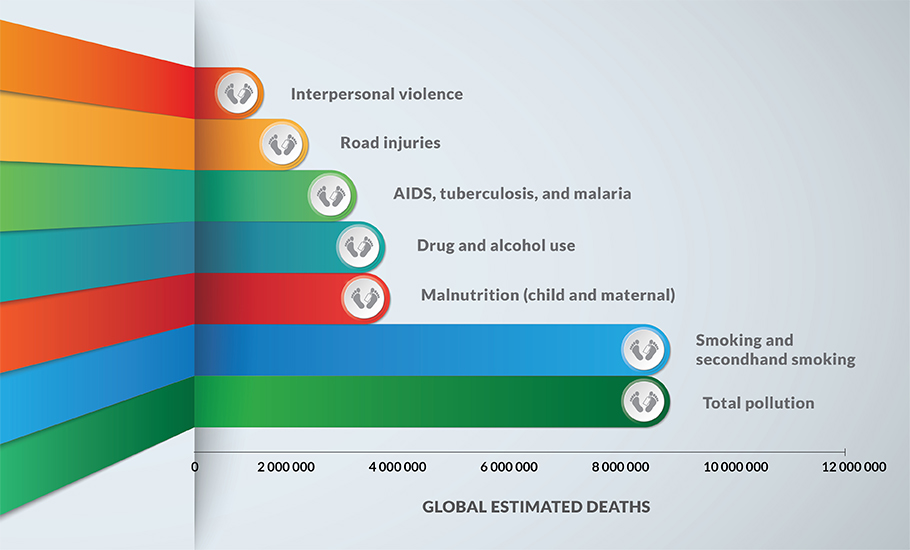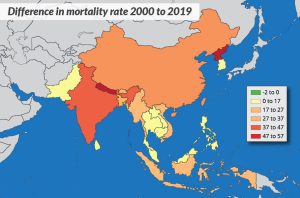
Pollution kills 9 mn people a year; nearly a quarter are from India: Lancet study
About the same number of people die due to air pollution each year as cigarette smoking and second-hand smoke combined, the Lancet study said

A new study blames pollution of all types for 9 million deaths a year globally, with the death toll attributed to dirty air from cars, trucks, and industry rising 55 per cent since 2000. That increase is offset by fewer pollution deaths from primitive indoor stoves and water contaminated with human and animal waste, so overall pollution deaths in 2019 are about the same as in 2015.
The United States is the only fully industrialised country in the top 10 nations for total pollution deaths, ranking 7th with 1,42,883 deaths blamed on pollution in 2019, sandwiched between Bangladesh and Ethiopia, according to a new study in the journal The Lancet Planetary Health.

Tuesday’s pre-pandemic study is based on calculations derived from the Global Burden of Disease database and the Institute for Health Metrics and Evaluation in Seattle. India and China lead the world in pollution deaths with nearly 2.4 million and almost 2.2 million deaths a year, but the two nations also have the world’s largest populations. When deaths are put on a per population rate, the United States ranks 31st from the bottom at 43.6 pollution deaths per 1,00,000. Chad and the Central African Republic ranked the highest with rates about 300 pollution deaths per 1,00,000, more than half of them due to tainted water, while Brunei, Qatar, and Iceland have the lowest pollution death rates ranging from 15 to 23. The global average is 117 pollution deaths per 1,00,000 people.
Rising numbers
Pollution kills about the same number of people a year around the world as cigarette smoking and second-hand smoke combined, the study said. “Nine million deaths is a lot of deaths,” said Philip Landrigan, director of the Global Public Health Program and Global Pollution Observatory at Boston College. “The bad news is that it’s not decreasing,” Landrigan said. “We’re making gains in the easy stuff and we’re seeing the more difficult stuff, which is the ambient (outdoor industrial) air pollution and the chemical pollution, still going up.” It doesn’t have to be this way, researchers said.
Also read: How far does India’s battery swapping policy address EV fire concerns?
“They are preventable deaths. Each and every one of them is a death that is unnecessary,” said Dr Lynn Goldman, dean of the George Washington University School of Public Health, who wasn’t part of the study. She said the calculations made sense and if anything was so conservative about what it attributed to pollution, the real death toll is likely to be higher.
The certificates for these deaths don’t say pollution. They list heart disease, stroke, lung cancer, other lung issues and diabetes that are “tightly correlated” with pollution by numerous epidemiological studies, Landrigan said.
Mainstream scientific thought
To then put these together with actual deaths, researchers look at the number of deaths by cause, exposure to pollution weighted for various factors, and then complicated exposure-response calculations derived by large epidemiological studies based on thousands of people over decades of study, he said. It’s the same way scientists can say cigarettes cause cancer and heart disease deaths. “That canon of the information constitutes causality,” Landrigan said. “That’s how we do it.” Five outside experts in public health and air pollution, including Goldman, told The Associated Press the study follows mainstream scientific thought.
Dr Renee Salas, an emergency room doctor and Harvard professor who wasn’t part of the study, said “the American Heart Association determined over a decade ago that exposure to (tiny pollution particles) like that generated from the burning of fossil fuels is causal for heart disease and death.”
“While people focus on decreasing their blood pressure and cholesterol, few recognise that the removal of air pollution is an important prescription to improve their heart health,” Salas said. Three-quarters of the overall pollution deaths came from air pollution and the overwhelming part of that is “a combination of pollution from stationary sources like coal-fired power plants and steel mills on one hand and mobile sources like cars, trucks, and buses. And it’s just a big global problem,” said Landrigan, a public health physician. “And it’s getting worse around the world as countries develop and cities grow.”

In New Delhi, air pollution peaks in the winter months. Last year, the national capital saw just two days when the air wasn’t considered polluted. It was the first time in four years that the city experienced a clean air day during the winter months. “That air pollution remains the leading cause of death in South Asia reconfirms what is already known, but the increase in these deaths means that toxic emissions from vehicles and energy generation is increasing,” said Anumita Roychowdhury, a director at the advocacy group Centre for Science and Environment in New Delhi. “This data is a reminder of what is going wrong but also that it is an opportunity to fix it,” Roychowdhury said. Pollution deaths are soaring in the poorest areas, experts said.
“This problem is worst in areas of the world where the population is most dense (e.g. Asia) and where financial and government resources to address the pollution problem are limited and stretched thin to address a host of challenges including health care availability and diet as well as pollution,” said Dan Greenbaum, president of the Health Effects Institute, who wasn’t part of the study.

